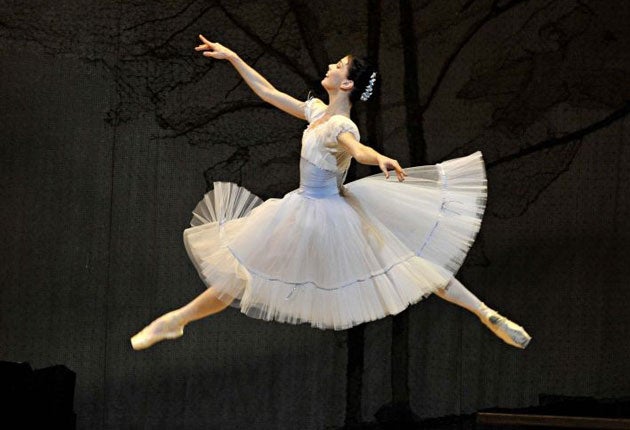Bolshoi: Serenade and Giselle/Coppélia, Royal Opera House, London
Russian star rises in tales of the east

The Bolshoi Ballet's Giselle is a ropey production with an extraordinary heroine at its heart. Natalia Osipova's Giselle is danced ardently and acted with desperate vulnerability. Around her the performance varies, from very wooden courtiers to a stronger corps de ballet of vengeful ghosts.
In some ways, this is a very unexpected performance. Osipova is natural casting for the bouncier end of the repertory – the flirty, mischievous heroines of Coppélia or Don Quixote. Giselle is a village girl who dies after being seduced by a lying aristocrat, and then returns as a ghost.
The ballet's first act can be played with some mischief. Instead, Osipova's heroine is painfully shy. Sitting on a bench, she spreads out her skirts, leaving no room for her lover, Albrecht. It is often a teasing moment, but that does not occur to this Giselle. She is nervously conscious of herself and of him when she draws in her skirts to make room. Osipova stresses Giselle's physical frailty, too: her heart pain, after the exertion of dancing, is a moment of real giddy sickness.
Yuri Grigorovich's production doesn't help. Simon Virsaladze's forest is splattered with acid yellow leaves and his costumes are often ugly. The village festivities are weakly carnivalesque, the peasantry vaguely waving tambourines. The Duke's hunting party look downright embarrassed by their particoloured tights and stuffed falcons.
The ghostly second act is some improvement. Maria Allash is stern and lucid as the Queen of the Wilis, summoning Giselle and the other ghosts to dance. The corps dancing is clear and confident. But it is Osipova's night: the performance lifts when she is on stage.
With just two acts, Giselle is one of the shorter 19th-century classics. The Bolshoi danced Balanchine's Serenade as a curtain-raiser. It has a very different, New World energy.
In Coppélia, Osipova scampers on stage with a little jump, so springy that she seems to hang in the air. Her performance, like the production, is irresistibly buoyant.
The ballet draws on ETA Hoffmann's tales, sweetened with village festivities and a love story. The villagers mistake Coppélius's mechanical doll for a real person. He hopes to turn her into a living girl, a creepy image the ballet doesn't push too far. Toys and villagers rush into dance at every opportunity, pushed along by the bouncy Delibes score.
Russian companies have been going back to the sources of 19th-century ballets, examining contemporary notations and designs. Sergei Vikharev's new production draws on the 1894 version, an influential staging by Petipa and Cecchetti. What's lovely is how lively it is. The Bolshoi don't dance this as a museum piece, but with exuberant freshness.
The sets, recreated from 1894 designs, suggest a solid, prosperous society – there is a touch of sumptuousness to Coppélius's workshop. Costumes are handsomely realised, from the embroidered peasant dresses to the fanciful dresses for Coppélius's dolls.
The Bolshoi season runs to 8 August (020 7304 4000; Roh.org.uk)
Join our commenting forum
Join thought-provoking conversations, follow other Independent readers and see their replies
Comments